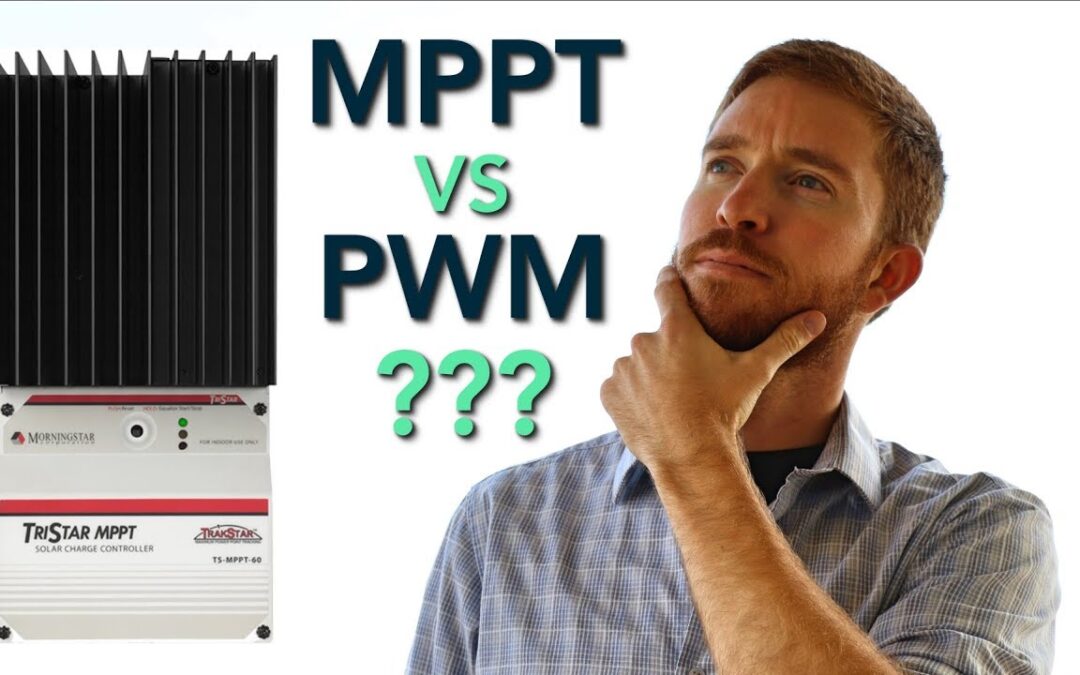MPPT vs PWM: Which one is the best solar controller for my system?
We have compiled a small amount of information that will hopefully help you to understand better what the difference is, and what type you should opt for in the MPPT vs PWM debate when it comes to your system.
A solar charge controller is needed in virtually all solar power systems that utilise batteries. The job of the solar charge controller is to regulate the power going from the solar panels to the batteries. Overcharging batteries will at the least significantly reduce battery life and at worst damage the batteries to the point that they are unusable.
The most basic charge controller simply monitors the battery voltage and opens the circuit, stopping the charging, when the battery voltage rises to a certain level. Older charge controllers used a mechanical relay to open or close the circuit, stopping or starting power going to the batteries.
More modern charge controllers use Pulse Width Modulation (PWM) to slowly lower the amount of power applied to the batteries as the batteries get closer and closer to fully charged. This type of controller allows the batteries to be more fully charged with less stress on the battery, extending battery life. It can also keep batteries in a fully charged state (called “float”) indefinitely. PWM is more complex, but does not have any mechanical connections to break.
On the other hand of the MPPT vs PWM debate is the most recent and best type of solar charge controller; Maximum Power Point Tracking or MPPT for short. MPPT controllers are basically able to convert excess voltage into amperage. This has advantages in a couple of different areas.
Most solar power systems use 12 volt batteries, like you find in cars. (Some use other voltages and the same advantages apply to these systems as well.) Solar panels can deliver far more voltage than is required to charge the batteries. By, in essence, converting the excess voltage into amps, the charge voltage can be kept at an optimal level while the time required to fully charge the batteries is reduced. This allows the solar power system to operate optimally at all times.
Another area that is enhanced by an MPPT charge controller is power loss. Lower voltage in the wires running from the solar panels to the charge controller results in higher energy loss in the wires than higher voltage. With a PWM charge controller used with 12v batteries, the voltage from the solar panel to the charge controller typically has to be 18v. Using an MPPT controller allows much higher voltages in the cables from the panels to the solar charge controller. The MPPT controller then converts the excess voltage into additional amps. By running higher voltage in the cables from the solar panels to the charge controller, power loss in the cable is reduced significantly.
When using high voltage “Grid Connect” panels with VOC voltages above 35v to charge a 12v battery bank, the only controller option is an MPPT charge controller.
The final function of modern solar charge controllers is preventing reverse-current flow. At night, when solar panels are not generating electricity, electricity can actually flow backwards from the batteries through the solar panels, draining the batteries. You’ve worked hard all day using solar power to charge the batteries; you don’t want to waste all that power! The charge controller can detect when no energy is coming from the solar panels and open the circuit, disconnecting the solar panels from the batteries and stopping reverse current flow.
When assessing which type of solar charge controller to purchase, you need to know about their functionality and features but it’s also helpful to see a straightforward comparison of your options. To that end, we’ve put together a comprehensive look at the pros and cons of both PWM Type Solar Controllers and MPPT Solar Charge Controllers for your convenience!
| PWM Type Solar Controllers | MPPT Solar Controllers |
| PROS | |
– PWM controllers are built on a time tested technology. They have been used for years in Solar systems, and are well established – These controllers are inexpensive, usually selling for less than $350 – PWM controllers are available in sizes up to 60 Amps – PWM controllers are durable, most with passive heat sink style cooling – These controllers are available in many sizes for a variety of applications | – MPPT controllers offer a potential increase in charging efficiency up to 30% – These controllers also offer the potential ability to have an array with higher input voltage than the battery bank – You can get sizes up to 80 Amps – MPPT controller warranties are typically longer than PWM units – MPPT offer great flexibility for system growth – MPPT is the only way to regulate grid connect modules for battery charging |
| CONS | |
– The Solar input nominal voltage must match the battery bank nominal voltage if you’re going to use PWM – There is no single controller sized over 60 amps DC as of yet – Many smaller PWM controller units are not UL listed – Many smaller PWM controller units come without fittings for conduit – PWM controllers have limited capacity for system growth – Can’t be used on higher voltage grid connect modules | – MPPT controllers are more expensive, sometimes costing twice as much as a PWM controller – MPPT units are generally larger in physical size – Sizing an appropriate Solar array can be challenging without MPPT controller manufacturer guides – Using an MPPT controller forces the Solar array to be comprised of like photovoltaic modules in like strings |


